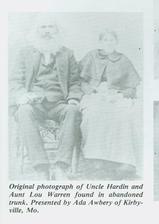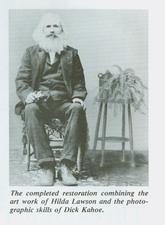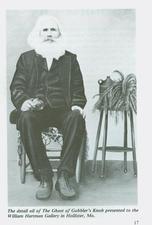Hardin Warren, Ghost of Gobbler's Knob
 How to Conjure a Ghost
How to Conjure a Ghost
by Viola Hartman
Ozarks Mountaineer, July 1978, page 16
"All that remained was a ghostly image on an ancient photograph--a faded picture of a bearded man seated beside a diminutive woman so tiny a thick pillow had been added to the chair on which she was perched in order to give balance to the scene. The style and general characteristics dated the period as the 1870's and a crudely penciled notation identified the pair as Uncle Hardin and Aunt Lou Warren.
"Then, research and modern science combined in a conjuration--causing to appear the original of that ghost and to produce the magic displayed at a reception in Hollister, Mo., honoring one of the Ozarks' most colorful personalities. A portrait was unveiled and presented to William Hartman to place in his gallery of Civil War heroes. He is the only Ozarkian in the group and will rest in the elite company of Generals Grant, Lee, Beaureguard and Jackson--a fitting tribute to the man called 'Ghost of Gobbler's Knob.'
" The six words on the relic found in an abandoned trunk led to an obituary dated Feb. 14, 1910. It stated, 'Hardin Warren, one of the oldest residents of Taney County, Missouri died yesterday. He was buried today in Gobbler's Knob Cemetery." And from that succinct statement the story of Mr. Warren unfolded.
The six words on the relic found in an abandoned trunk led to an obituary dated Feb. 14, 1910. It stated, 'Hardin Warren, one of the oldest residents of Taney County, Missouri died yesterday. He was buried today in Gobbler's Knob Cemetery." And from that succinct statement the story of Mr. Warren unfolded.
"He was one of the first pioneers in Western Taney County, settling after his discharge from the Union Army. He had served in both the Mexican and Civil Wars and parlayed his bounty land grants into a sizeable homestead along the stage route on Gobbler's Knob. To this he added the Fortner land, 160 acres of what was to become the nucleus of Hollister. His signature was a bold X on the titles of it and other properties he amassed and covered with stock and cash producing crops. His domain was vast and he rode through it on a huge stallion, shotgun across the saddle and a jug of corn liquor hanging from the saddle horn. It was a trouble-filled time and he was not known to avoid any that sought him out. His size, daring and deadly accuracy with a gun made him a respected opponent in any fight. He made no secret of the fact that his wealth was in gold, buried only he knew where.
"He provided a home and education for several orphans, contributed to the welfare of numerous individuals and kept his own counsel as to his private affairs. He donated ground for the cemetery and school on Gobbler's Knob 'for purposes to be held sacred forever' and was a good friend and neighbor to all regardless of politics, religion or the flag they may have served. In short, he was a man of substance and considerable power and prestige who helped to build a new society in the backwash of a national conflict--the rise and fall of the Baldknobber era.
"The challenge of age he met with the same confidence that had marked all of his 90 years and by the time physical impairment restricted his actions he had found a way to die with his responsibilities discharged. He left secure in the belief his final wishes would be carried out and at his death only a small checking account remained in his name. He had made his fortune and disposed of it as he wished--except for the gold which was never found. By the turn of the century the code he lived by had all but passed into oblivion and except for the aged photograph he existed only in the minds of those who claimed to have seen his ghost in the moonlight riding the ridges of Gobbler's Knob.
"It was in the spring of 1978 when a capricious fate brought the photo and story to the attention of Dick Kahoe, a photographer with a keen interest in the restoration of historical photographs. From his view point it is one of the warmest, most meaningful and human art forms around and he believes that photos, coupled with the written word effectively tie the past to the present. It is therefore important to bring back the best possible picture--and he enjoys the conjuring.
"When he sa w the dim likeness captured a century ago, the challenge was irresistible. 'While it was undoubtedly of historical importance,' he said, 'its condition was one of the worst I'd ever seen.' He was determined to revive the 'ghost' and preserve the image to go with the recalled story of Hardin Warren...'Sometimes it is a long and involved process as was the case here but the results of the magic is worth all of the effort that problem demanded.' He paused for just a moment, then added, 'You may be interested to know that at the presentation two interesting questions came up. They were, 'What happened to Aunt Lou' and, 'Now that Hardin Warren is restored to full and lifelike color, will the ghost finally be at rest?'
w the dim likeness captured a century ago, the challenge was irresistible. 'While it was undoubtedly of historical importance,' he said, 'its condition was one of the worst I'd ever seen.' He was determined to revive the 'ghost' and preserve the image to go with the recalled story of Hardin Warren...'Sometimes it is a long and involved process as was the case here but the results of the magic is worth all of the effort that problem demanded.' He paused for just a moment, then added, 'You may be interested to know that at the presentation two interesting questions came up. They were, 'What happened to Aunt Lou' and, 'Now that Hardin Warren is restored to full and lifelike color, will the ghost finally be at rest?'
'My answer to number one was that in the 'conjuring' when the vapor cleared, a jug of Warren's favorite brew had replaced her. And the second question, if a cache of gold was within your reach, would you?'"
___________________________________________________
Ms. Hartman's article goes into much detail about the photographic process used to restore old photographs. The original, full magazine article is available at the Library Center. For more about the ghost see The ghost of Gobbler's Knob and other tales of the hill country also by Viola Hartman.
Find this article at http://thelibrary.org/blogs/article.cfm?aid=2612&lid=37&view=print